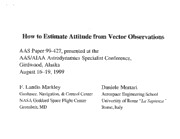
How to Estimate Attitude from Vector Observations PDF
Preview How to Estimate Attitude from Vector Observations
How to Estimate Attitude from Vector Observations AAS Paper 99-427, presented at the AAS/AIAA Astrodynamics Specialist Conference, Girdwood, Alaska August 16-19, 1999 F. Landis Markley Daniele Mortari Guidance, Navigation, & Control Center Aerospace Engineering School NASA Goddard Space Flight Center University of Rome "La Sapienza Greenbelt, MD Rome, Italy Wahba's Problem - SIAM Review, July 1965 Find the orthogonal matrix A with determinant +1 that minimizes L(A)= 2Xiai]bi - Aril 2 where {be} are unit vectors in a body flame, {re} are unit vectors in a reference flame, and {ai} are non-negative weights. Writing L(A) -/t o - tr(ABT), with A0 - Ziai and B - Ziaibi rw, it is clear that we can minimize L(A) by maximizing tr(ABT). This is equivalent to the orthogonal Procrustes problem, which is to find the orthogonal matrix A that is closest to B in the sense of IMII the Frobenius norm, - tr(MM w), since - Xi,jMi_ BII IIBII +IBI Z - - Z[l_ + - 2tr(ZB T) - 3 - 2tr(AB T) Solutions- SlAM Review, July 1966 First l:J. L. Farrell and J. C. Stuelpnagel: B has the polar decomposition B - WH where W is orthogonal and H is symmetric and positive semidefinite. If detW is positive, then W. Aop t- Else, diagonalize H by H- VDV T, where V is orthogonal and D is diagonal with elements arranged in decreasing order. 1 detW]V T. Then WV diag[1 Aop t - 2: R. H. Wessner: Aopt _ (BT)-I (BTB)1/2, which is equivalent to Aop t - B(BTB) -1/2. This requires 3 vectors (detB _: 0); only 2 are really needed. 3-6: J. R. Velman, J. E. Brock, R. Desjardins, and Wahba. Singular Value Decomposition (SVD) Method - 1987 B has the Singular Value Decomposition: B- U Z VT - U diag[Z,, Z22 _33] vT, where U and V are orthogonal and Z_l > _]22 _-_ _]33 _ 0. 1 (detU)(detV)] VT. The optimal attitude matrix is U diag[1 Aop t- The SVD method is completely equivalent to the Farrell and Stuelpnagel solution with U- WV. The difference is that SVD algorithms exist now and are among the most robust numerical algorithms. MATLAB computes B in two lines of code. Aop t from QUaternion ESTimator (QUEST) - 1978 The first three rows of I- K )qopt- 0 give (/_'max 1 Ix]where x = {adj [(/],ma × + trB)l- B- BT]} z qopt = J7 _+Ix2l _ ' and ]/- det[(_ma x + trB)l- B- B T ] Find/lm= _ by Newton-Raphson iteration of the characteristic eqn., det(_ma × l- K) tr B)7 - (/_'max -- - zTx -- 0. Iterate from 20, since/_'max is very close to Ao if L(Aop t ) --/_0 --/_max is small. The analytic solution is slower and no more accurate. QUEST would fail for 180 ° rotations, but the method of sequential rotations (effectively permuting q components) handles this case. of the Optimal Quaternion (ESOQ) - 1996 EStimator Solve the characteristic equation for/_ma_ as in QUEST. The adjoint of _maxI- K can be shown analytically to obey I- K) adj(_ma x - (_max -/_'2)(_max -- '_'3)(_max -- '_'4)qoptqTpt , where X2, 2,3, and _,4are the other three eigenvalues of K. Thus be computed by normalizing any non-zero column of qopt can adj(/_ma_ I-K ). This is the "4-dimensional cross-product" of the other three columns of/_max I- K. ESOQ2 - 1997 _ Iesin(¢ / 2)q into I- K gives )qopt- 0 (/_max cos(q_ / 2) J Substituting qopt L (&m_ -- trB) cos(0 / 2) - eXzsin(O / 2) and [(2m.x + trB)I- B- B x ]esin(O / 2) - zcos(O / 2). Eliminating the rotation angle 4_gives Me- 0, where M trB)[(Am_x + trB)I- B- B v ]- zz r - [m_ m 2 m3]. -('/]'max -- The rotation axis is e- Y/lYl,where y is any mix mj. Then 1 I, mtra" ':yl qopt -- trB)yl 2 + (z. y)2 y _/l(/_,max -- Fast Optimal Attitude Matrix (FOAM) - 1993 Find/_'max by solving the characteristic equation o - (2 -IIBII)_2, det B- 4lladjBil2F. _ 8/_, This becomes an easily solved quadratic in/_2 if det B- 0, as in the case of two observations. The attitude matrix is given by IBll2BF) Aopt- - det B)-l[( K + + _maxadj Br - BBrB], (/('/_'max where t¢ - ½(/_2ma-x-IIB2ILF)" the For the analysis in this paper, the quaternion representation of optimal attitude is computed. ESOQ, ESOQ2, and FOAM avoid QUEST's sequential rotations. Two-Observation Case In this case detB- 0, the odd terms in ,_ in the characteristic equation vanish, and 2 /l,m_x -- _]a_ + a2 + 2ala2[(b , •b2)(r _•rz)+ [bl x b211r_x r211 • This simplifies both QUEST and FOAM; FOAM gives Aop t - b3F.3T "_- (al/_max)[blr? + (bl × b3)(rl × r3) T] (b 2 x b3)(r 2 x r3)T], + (a2/_max)[b2r2 + where b 3 -(b 1x b2)/Ib 1x b21 and r3 -(r 1x r2)/Ir 1x r21. This goes over to the TRIAD solution for a_ -0, a2-0, or a_ Sequential Methods The basic idea is to propagate B or K to time t and then update. Filter QUEST -1989 k+n t B(new) -/_3×3B(old) + sum over n, observations at t. Z aibirT, i=k+l Recursive QUEST (REQUEST) -1996 k+n t K(new)-/_(I)4×4K(old)_ v aigi' where 4X4 "+" E i=k+l (bi × ri)T bi.r i • These are mathematically equivalent. Filter QUEST requires fewer computations, but neither has been successful in practice.
